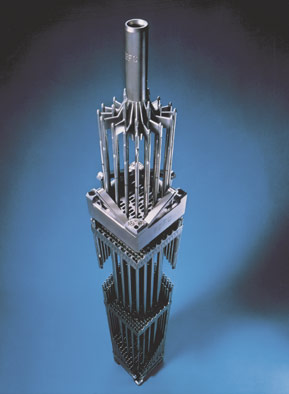The steering tools of the fission rate in reactors
The control of the chain reaction rate is achieved by varying the amount of neutrons absorbers in the core of a nuclear reactor. First there is the objective of safety and to avoid an accident through the divergence of the chain reaction. Second, operators need to control the amount of power delivered by the reactor.
There is two ways of acting on the fission rate : neutrons absorbing rods – grouped in “control rod assemblies » – removed from or inserted into the core of a reactor ; Addition of a soluble neutron absorber (boric acid) – diluted in primary water.

Control rod assemblies
Model of a fuel assembly of pressurized water reactor showing the head of the control cluster at the top and in the middle the guide tubes of control rods along the fuel rods that were cut for visibility. The absorber rods are suspended to a structural part called the « spider », which allows to simultaneously control the movement of the 24 pencils with a single command rod passing through the lid of the reactor vessel.
© Framatome
In the PWR design a soluble neutron absorber (boric acid) is added to the reactor coolant to regulate the long term reactivity of the core. During stable operating conditions when the reactor power is stationary, a suitable amount of boric acid ensures an even power and neutron without resorting to control rods.
Boric acid has the advantage to be uniformly distributed in the volume of the core, but its concentration can not vary rapidly, while the control rods are used for rapid changes to the reactor power (e.g. shutdown and start up). They can be introduced very quickly into the core, when it is desirable to stop the reactor as a preventive measure or in case of accidental situation. The fall of control rod assemblies then provides immediate stop of the reactor.
Approximately one third of the fuel assemblies in the core of the reactor are equipped with a control rod assembly. Each assembly consists of 24 pencil-like absorber rods sliding in the guide-tubes of the associated fuel assembly.
These rods are suspended from a structural part called « spider », which can simultaneously control the movement of the 24 pencils with a single command rod that passes through the lid of the reactor vessel. The vertical displacement of the command rod is achieved thanks to mechanisms located above the lid.
The ascent or descent of the control rod assembly is usually done via a succession of small up or down movements. We can raise or lower the control rods, step by step, or obtain their immediate release and thus the fall of the assembly by gravity. The fall time is about 2 seconds, but the neutron absorption acts early in the insertion.

Intervention on a control rod assembly at a reactor of the Civeaux EDF nuclear power plant in France.
© Clefs-CEA
There are two types of control assemblies in French PWR, said black and gray. The black assemblies are very absorbent: their 24 rods are made of an alloy bar of Silver-Indium-Cadmium (AIC) or boron carbide, two materials that strongly capture neutrons. Gray assemblies contain only 8 absorber rods, the 16 others being made of stainless steel: the whole is much less absorbing. Control assemblies are not operated one by one, but in groups of 4 or 8 symmetrically distributed in the core.
One can distinguish as follows:
– Stopping assemblies kept outside the core in the up position when the reactor is operating; they are black assemblies, whose number is chosen so that their fall induce the shut down of the chain reaction;
– Groups of gray and black clusters, to command the operating power;
– A group of gray clusters for regulation, enslaved to the average temperature of the primary water.
In reactors burning MOX fuels are introduced into the core, it is necessary to increase the number of control assemblies to control the reactor reactivity.